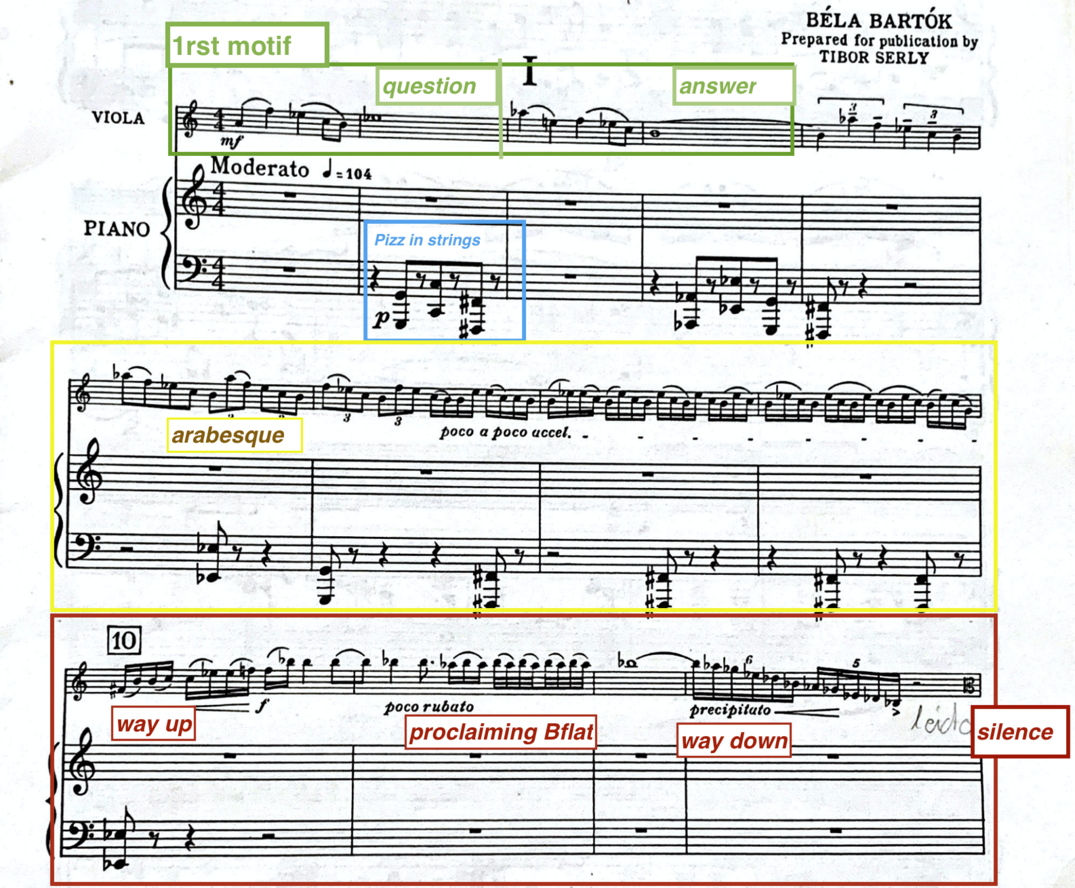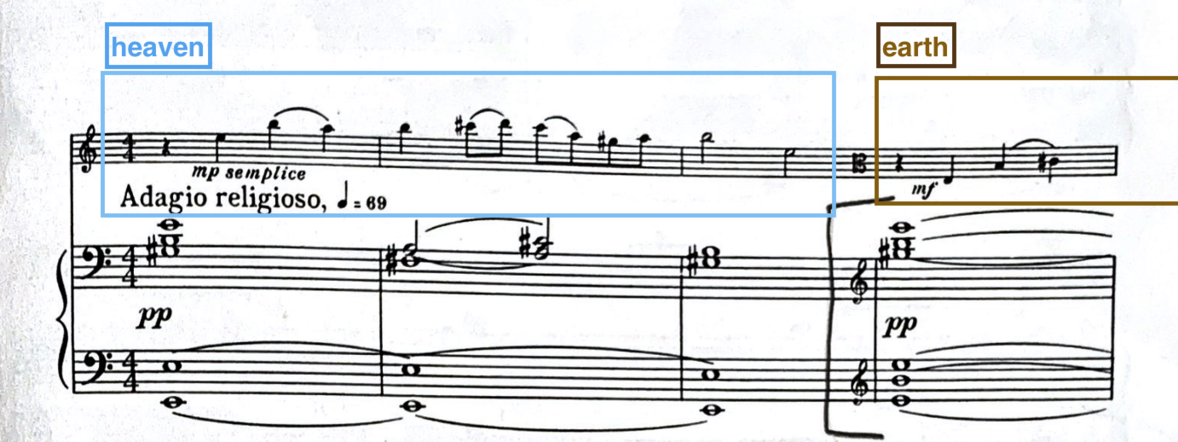Like a call from out of nothing, the movement starts with a lyrical melody in the viola, introducing the first main motif of this movement. The diminished intervals of the melody, combined with traditional folk elements immediately draw the ears of the listener.[1] The first two bars contain a question which is answered by the 3rd and 4th. This 1st motif, in which traditional folk elements are incorporated symbolizes a certain existential struggle. The accompanying pizzicato played by the strings in the orchestra creates an ominous atmosphere. After the 1st motif is introduced, the viola starts to wander through an arabesque-like labyrinth which is built by the intervals that are set. The melody in the viola seems to get caught in an arabesque-like labyrinth until it finds a way out in a line upwards to a repeated proclaiming Bflat and then falls two octaves down. The tonality of this first movement is still not set.
After a moment of silence, the 1st motif is repeated again an octave lower (bar 14), producing a warmer and deeper sound, accompanied by a descending line of minor seconds in the strings. This descending line of minor seconds is the second main motif of this piece. Once the viola reaches the lower C for the first time, the orchestra makes its entrance with the 1st motif played by the woodwinds. Again, the 1st motif culminates into an outburst.
In this last part there is a syncopated rhythm that insinuates a Hungarian folk dance. However, the character of this dance is more macabre. In his book, Mikhail Kugel describes a rhythmic and melodic relationship between the themes in this final movement and the explosive passages of the first movement.[1]
In this transition to the second movement, the peaceful atmosphere created by the C major chord at the end of the first movement is suddenly interrupted by a tormented cry. The viola plays a C# followed by a D# major chord played in the orchestra.
Throughout this movement a more ominous harmony appears which culminates in a hysterical state of despair. The viola plays a syncopated rhythm in a higher register, accompanied by changing tremolo chords in the strings (bar 30).
Throughout this movement, the viola seems to be caught in a labyrinth until suddenly the atmosphere changes. Like an ‘‘oasis in the middle of the desert’’, there are Hungarian farmers dancing to the music of a gypsy orchestra. The atmosphere is delighted and carefree and it seems as if we are back in the Hungarian countryside, but soon we are swept away by the darkness that lurks.[1]
NB. This interpretation of the concerto is based on the orchestra score of the Serly Edition. The excerpts that I have included in this paper, however, are based on a piano reduction, since this gives a more easily comprehensible overview
After this second outburst, the 1st motif is played by the viola for the third time (bar 25). This time, the theme is accompanied by warm floating chords played by the strings. In bar 29 the melody in the viola is now continuously moving between consonants and dissonants. The 1st motif repeats again, now with a more heroic sound. Again, the motif falls into a labyrinth followed by an outburst. This time, this outburst ends in a rhythmical explosive passage (bar 41-52).
Right after this turbulent passage, like a survivor from the war, the 1st motif shows up again, this time in an altered version (bar 53-54).
As a final statement of this movement, the 1st motif returns once more in a noble character. Shortly afterwards, this theme is repeated, singing in the high register of the viola, and with an Aflat chord in the orchestra giving a more despairing but also questioning character. After a few little outbursts, the final word is said and the movement ends in a C-major chord.
After this moment of desperation, fragments from the heaven-like theme return. However, they are brutally disturbed by dissonant chords in the horns. After the last failed attempt to stay in the heaven-like atmosphere, the 1st motif from the first movement enters (bar 40). The temper is miserable and mourning. After this final quotation of the 1st theme, a cadenza-like accelerando leads us into the third movement.
After the explosive passage, the second main motif is played for the first time by the viola. This second motif is a melancholic descending line which has a pleading, whining and desperate character. This second motif could be a reference to Bartók’s homesickness or his despair regarding his illness, or the war. What is interesting, is that - like the first motif - this second motif develops into a wandering, elusive, labyrinth-like episode followed by an outburst.(bar 76) Therefore, I would say that this second motif creates no real contrast from the first.
After the outburst in bar 76 the 1st motif is played in the viola (bar 81). This time, the motif caries a mournful mood, as if it is begging for something. However, 4 bars later, as if a new insight has come to the surface, the motif is played again, this time with a more hopeful state of mind. After this phrase also ends in a labyrinth, the development of this first movement starts. This development contains variations on the first theme played by both the orchestra and the viola. In bar 128 a cadenza starts. In my experience, this cadenza is an inner conversation with the self. There is something tormented in the spirit of the cadenza. The cadenza finishes when the orchestra enters with the 1st motif played by the flute and the horn (bar 127) followed by the clarinet, the oboe and first violins. This time the motif has a calmer and more comforting atmosphere. However, it doesn’t last for long since soon the explosive passage enters for the second time (bar 162).
After the explosive passage, a variation of the 2nd motif is played by the viola accompanied by the bassoon playing the same motif (bar 185).
A foreign world has been entered. In attempting to get out by climbing higher, the earth slips away and one's grip on life gets lost. Falling through a downward spiral, the tempo accelerates. The falling stops when the viola arrives on a low C, just as in the first movement. However, instead of a peaceful fine, this lower C now represents limbo.
This movement represents an uncertain period of awaiting a decision or resolution. Concerning the title of the movement, Adagio Religioso, it could represent the space between life and death, heaven and earth, health and illness, the present and the past, and so on. The melodic lines in the viola have a questioning character. These questions are answered in the earthy-sounding lower tones.












